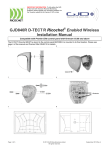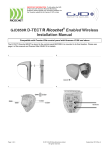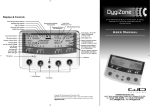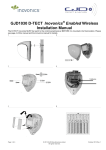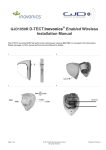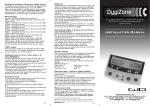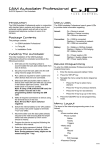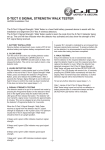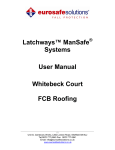Download GJD830R D-TECT R Ricochet Enabled Wireless Installation Manual
Transcript
IMPORTANT INFORMATION: To fully utilize the GJD D-Tect Unit with Texecom Ricochet Monitoring Software, please upgrade your monitoring software via the Texecom website to the Version 2.18.0 or later. GJD830R D-TECT R Ricochet® Enabled Wireless Installation Manual Compatible with Premier Elite control panel with firmware V2.08 and above The D-TECT Ricochet MUST be learnt to the control panel BEFORE it is mounted in its final location. Please see page 4 of this manual and Premier Elite INS467-5 for details. 1 2 3 4 1.Batteries 5 Page 1 of 4 6 © 2013 GJD Manufacturing Limited. All rights reserved. September 2013 Rev 4 7 8 9 10 Page 2 of 4 September 2013 Rev 4 Packaging The package contains: • • • • • • • • • 1x wireless detector 3x wall plug & screw sets 1x lens mask 2x additional curtain shutters 1x tamper cup 2x tamper caps (different lengths) 1x plastic opening tool 1x installation manual 1x drilling template for fixing holes Mounting holes should be sealed from within the detector using acrylic (non-silicone based) sealants. Silicone sealants must not be used as vapours may corrode the electronics and metal parts. Ensure the detector's field of view is unobstructed. Mounting the detector: 1. A hole-drilling template is provided. Notes GJD’s Ricochet® enabled D-TECT® The wireless detector uses a quad pyro where both sensors must trigger to cause the detector to signal an alarm ensuring precise and reliable presence detection. Programmable options include a variable pulse count and a choice of detection ranges up to 30 meters. The dual-axis tilt sensor allows 180° of pan and 90° of tilt. This increases the speed of the outdoor installation and provides accurate aiming of the detection pattern. • Use the tamper cup on uneven surfaces. • Optimum height for the detector is 3m. Higher mounting heights will result in reduced detection range. 2. Remove the cover assembly using the plastic opening tool and by loosening the locking screw. See Figure 2. 3. Screw the unit to the wall. Ensure the tamper pin is correctly located and the tamper switch is closed. Precision electronics, digital white light filtering, and double shielding eliminates false alarms from the sun. The detector housing has a professional appearance with the sensing module hidden behind the front cover. Drill the wall to accept the fixing screws and the tamper cup (if used). See Figures 1 and 3. Two different length tamper feet are provided for uneven surfaces. The tamper foot is a push-fit see Figure 1. 4. Quick installation 1. Place two CR123 batteries into the detector battery holders. Observe the polarity. See figure 4, item 1. The detection LED will flash four times. When the detector is aligned, powered and programmed: a. Fit the cover. b. Loosely tighten the locking screw. c. Push the two side plastic latches into the base. d. Tighten the locking screw. 2. With the Ricochet® expander in commission mode enter the learning menu on the control panel. To learn the device follow the instruction given in the control panel documentation. Batteries 3. Press and release the programming button once to learn the device. ( Fig 10, item 2).This action also activates walk test mode. Note: The learn process may take up to 10 seconds from pressing the programming button. Learn will be confirmed on the control panel. Observe correct polarity when fitting. 4. The detector will take approximately 3 minutes to settle. The detection LED is now enabled for five minutes. 5. Mount the detector following the instructions below. Note: To carry out a walk test the zone mode must be programmed to be ‘Always Awake’ and the front cover must be fitted and secured. The default settings are: • • Range: 30 meters Pulse count: 1 Fitting the detector Protect the electronics against water. Trapped moisture can affect or damage the unit. 3/4 Only use CR123 3 V Lithium batteries. Battery safety information • • • • • • Do not put in a fire Do not charge Do not heat Do not short circuit Do not disassemble Only fit batteries of the same type and voltage To preserve battery life the zone mode must be programmed to be “Auto” which introduces a 3 minute sleeptime. Beam alignment and masking The multifunction lens fitted to the GJD830R detector focuses seven long-range and seven medium to short-range curtain beams. The circuitry detects changes in heat and movement in the beam pattern. The presence of trees, shrubs, ponds, boiler flues, black tarmac and animals should be considered when positioning the detector. PIR sensors are more sensitive to movement across the beams and less sensitive to movement directly towards or away. September 2013 Rev 4 The detector is fitted with two sliding shutters to reduce the detection angle. To enter the walk test mode, press the programming button once. The unit can now be aligned. The shutters are clipped to the pan and tilt module as shown in Figure 5. Each vertical section of the Fresnel lens gives a coverage pattern of approximately 10 degrees. Walk test mode ends automatically five minutes after the last detection. An additional set of shutters is provided for further adjustment. Figures 7, 8 and 9 show typical beam patterns. A pet alley can be created my applying the lens mask as shown in Figure 9. Programming Do not conduct walk tests with the cover removed. The range of the detector increases without the protective front cover. Therefore the front cover must be fitted to establish the correct beam pattern. Adjust the range as necessary. Pan and tilt the detector module over the field of view to obtain the correct coverage. Specifications Figure 10 shows the position of the programming button (2) and the programming LED (1). Detection range Programmable: 10, 20 or 30m Coverage 10 to 70° detection angle, 30 x 25m coverage max. Adjustment 180° pan, 90° tilt Fresnel lens 28 zones for each detection element, which can be masked with the curtain sliders Optics Double silicon shielded quad element eliminates 50,000 Lux of white light LED Red alarm Batteries 2x 3 V CR123 Pulse count is the number of detections before signalling an alarm. Pulse count 1 is most sensitive. Current 50 µA Pulse count 1 or 2 Changing settings: Control Digital micro. with non-volatile memory Walk test Output test mode with LED indication Operating temperature −25 to +65°C Housing High impact ABS plastic with HDPE cover, UV stabilised Dimensions W x H x D 145 x 145 x 120mm Weight 268g Net, 425g Gross Mounting height Variable up to 6m Optimum height 3m Table 1: Programming settings Option 1 2 3 1. Range (m) 10 20 30* 2. Pulse count 1* 2 • 1. Default settings Press the programming button once for range and twice for pulse count. 2. Wait until the programming LED turns off (typically 4 seconds). 3. Count the number of times the LED flashes to determine the current value for that option. 4. Press the programming button to select the value number for the new setting. E.g. to change the range to 20m, press twice. The LED blinks twice to indicate that the new value was set. Programme settings are stored in non-volatile memory. Compliance Manufacturer Resets GJD Manufacturing Limited, Unit 2, Birch Business Park, Whittle Lane, Heywood, Lancashire, OL10 2SX, UK 1. Remove the batteries. Certification 2. Press and hold the programming button (See Figure 10, item 2). R&TTE 3. Refit the batteries. This device is in compliance with the essential requirements and other relevant provisions of Directive 1999/5/EC. 4. After the programming LED has flashed, release the programming button. Environmental class IP65 Learning to control panels When the control panel is in learn mode press the detector programme button once. After about 10 seconds the wireless detector will be learnt on to the control panel. 2002/96/EC (WEEE directive): Products marked with this symbol cannot be disposed of as unsorted municipal waste in the European Union. For proper recycling, return this product to your local supplier upon the purchase of equivalent new equipment, or dispose of it at designated collection points. For more information see: www.recyclethis.info. Walk test Contact information In walk test mode, the detection LED option is set to ‘ON’ and the detection LED will illuminate on detection. Web: www.gjd.co.uk Tel: +44(0) 1706 363 998 Email: [email protected] Page 4 of 4 September 2013 Rev 4




